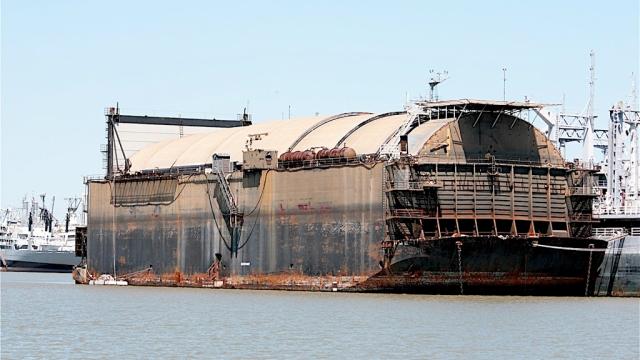When an advanced Soviet submarine sank in the Pacific in 1968, the CIA decided to risk World War III on a daring covert mission, using this massive barge to raise the sunken vessel and pry out its secrets.
After Soviet submarine K-129 sank 2400km northwest of Oahu in March of 1968, few held out hope of ever recovering the vessel, or the 98 crewmen that died aboard it, from its 5km deep watery grave. While multiple Soviet recovery forays failed to locate the wreck, the CIA managed to find it. In 1974, the agency set about raising the submarine from the depths. It was no easy task.
For one, it was the middle of the friggin’ Cold War — had the Russians discovered what the Americans were up to, it could have easily caused an international incident. For another, K-129 came to rest three miles below the surface — far deeper than any sub-sea recovery operation that had ever been previously attempted. So not only did the CIA have to develop a new means of deep sea salvage, it had to do so in utter secrecy. And that’s where the Hughes Mining Barge came in.
The Hughes Mining Barge, designated HMB-1, was a football field-sized submersible barge — 90m long, 30m wide and 27m tall — sporting a fully retractable roof, a gigantic internal moon pool, and a purpose-built crane dubbed The Claw. It was also the centrepiece of Project Azorian, one of the most sophisticated and expensive operations conducted by either side during the Cold War, costing $US800 million in 1974 bucks — which adjusts to just under $US3.2 billion today.
Under the guise of a deep sea magnesium mining operation, the HMB-1 would be towed to the wreck site then sunk onto stabilising piers embedded on the seafloor. The HMB-1, with help from a second vessel, the Glomar Explorer, then plucked the sub from the ocean’s depths and raised it through the internal moon pool, out of sight of prying Soviet satellites, before whisking it away to ports unknown.
After the successful raising of K-129, the purpose-built HMB-1 was mothballed in San Francisco’s naval shipyard until 1982, when its unique capabilities were again put to use — this time as a floating home to Lockheed’s experimental stealth ship, the Sea Shadow. However, this gig only lasted until 1986, when the Navy scrapped the program and again mothballed the HMB, as well as the Sea Shadow, for the next 27 years.

Earlier this year, the Navy announced plans to scrap the Sea Shadow, deeming it unfit for commercial use and the HMB along with it. However, the HMB has once again found new life at the Bay Ship & Yacht Company, which bought the hulking vessel for $US2.5 million and now uses it as a floating dry dock. At least, that’s the official story. [Wiki – NBC – Daily Mail – Aviation Intel]
